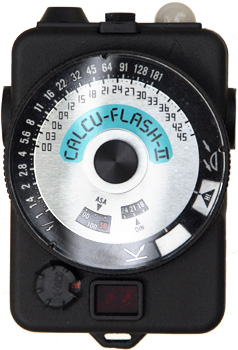
|
  Maker: Quantum Instruments Model: Calcu-Flash II Circa: 1981 Price (new): $125 (1981) - $195 (1999) Cell type: Silicon blue Battery: Energizer 357 or equivalent Measure type: Incident flash |
|
Quantum tweaked and updated the Calcu-Lite several times with different model names, but the basic configuration remained the same. This is (I believe) the last version. The silicon cell sits under an interchangable cover so you can go back and forth between incident and reflected light. It's capable of measuring flash and integrating it with ambient readings, and it has a memory so you can measure contrast ratios. Best of all, you can still buy batteries for it. As they say on the British tv show Top Gear: It's brilliant. It's not intuitive—I had to read the manual to figure it out, but once I did it it worked fine. It's nicely designed, can be used one-handed, it fits beautifully in its case so you can use it without taking it completely out (unless you want to physically connect a sync cord). It looks as if it were designed by people who actually use these things. I was surprised at how inexpensive and easy they are to find on eBay. Mine came with all the standard accessories and appears to be very gently used, and I paid about $30 for it. Considering that flash meters are one of the few types that haven't been made obsolete by modern camera meters, I would think the resale demand and values would be higher. My Wein WP1000 is similarly undervalued. |
|
©opyright by James Ollinger. All Rights Reserved.
Company names and models are registered trademarks of their respective owners
and are not affiliated with this website in any way.

s.jpg)